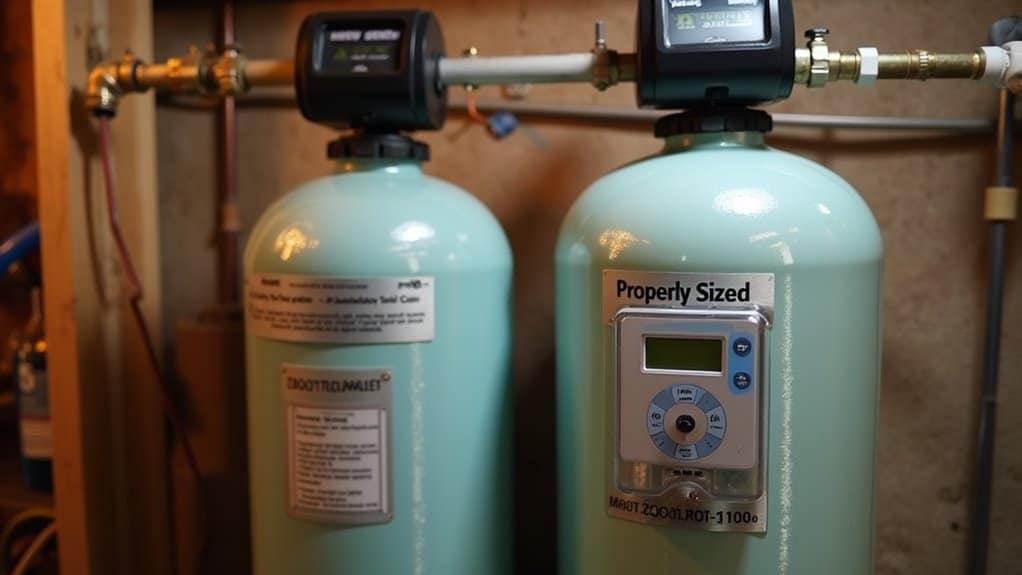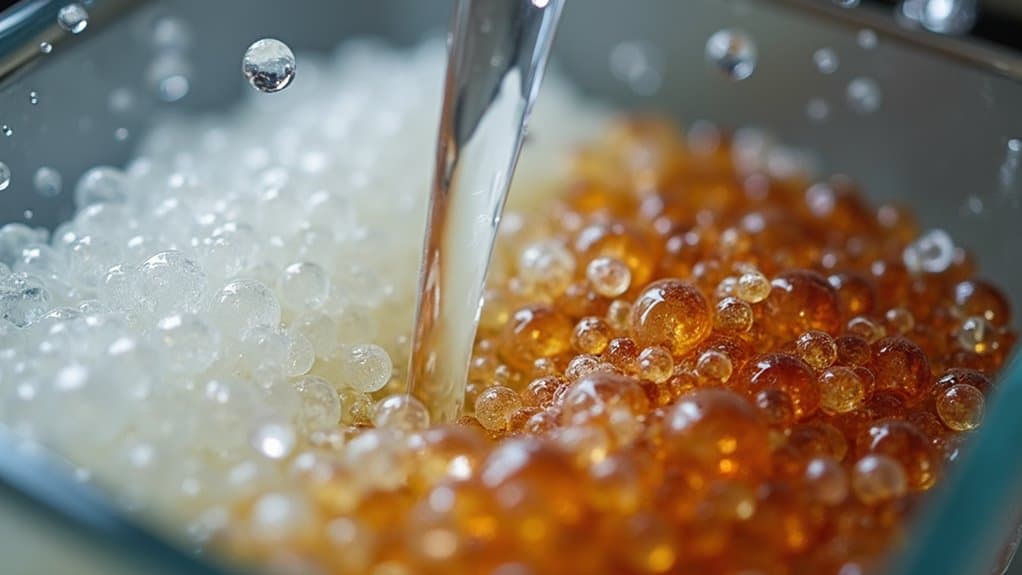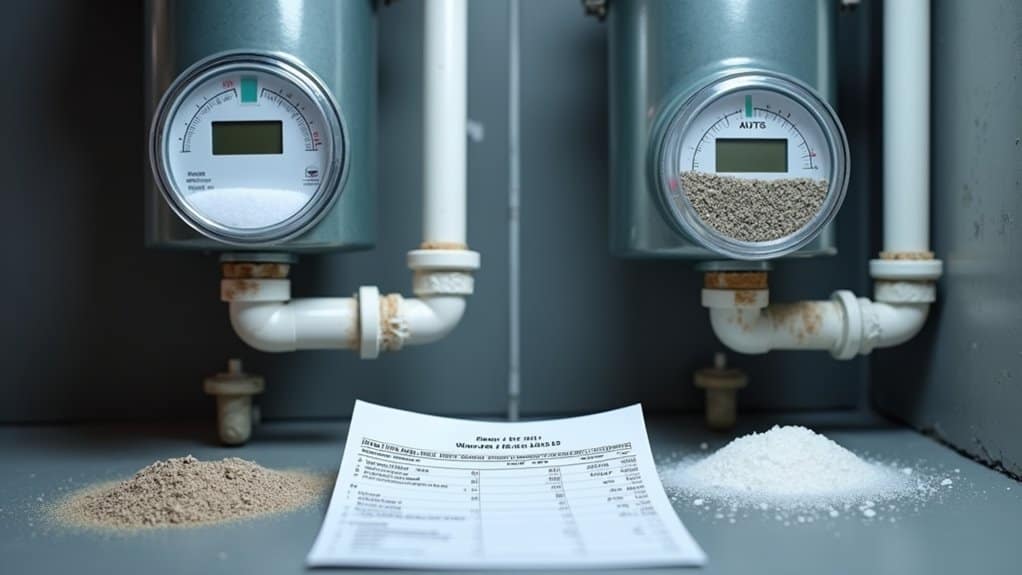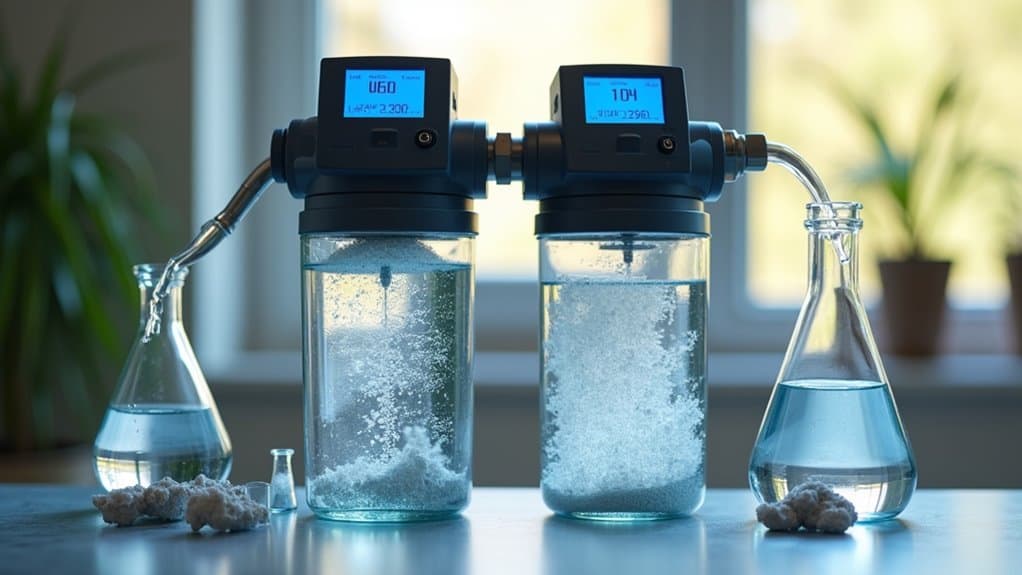Most water softeners deliver less than half their advertised grain capacity in real-world conditions. Your “32,000-grain” system likely operates at just 15,000 grains when properly configured. Installers often use outdated sizing formulas that ignore iron contamination, peak demand periods, and actual usage patterns. This leads to premature appliance failure, excessive salt consumption, and inefficient performance. Understanding true operational thresholds can help you select a system that delivers optimal long-term value rather than minimal upfront cost.
Key Takeaways
- “32,000 grain” ratings are theoretical maximums that perform 30-50% lower in real-world conditions.
- Most installers use oversimplified calculations that ignore peak demands and specialized water uses.
- Iron contamination drastically reduces capacity, with each 1 ppm of iron decreasing capacity by 4 gpg.
- Systems operating beyond 75% of rated capacity waste salt, water, and experience shortened resin lifespan.
- Intentionally oversized systems can reduce salt usage, extend resin life, and minimize regeneration frequency.
Why Traditional Water Softener Sizing Formulas Fall Short

While many water treatment professionals rely on traditional softener sizing formulas, these calculations consistently fail to deliver optimal performance in real-world applications.
These formulas make static assumptions about water usage patterns, ignoring peak demand scenarios and concentrated usage times that impact system performance. Incorrectly assessing water hardness levels can exacerbate these issues, leading to even more inefficiencies.
Most equations neglect critical factors like burst capacity needs during high-demand periods and fail to account for variable household behaviors.
They also overlook peripheral water demands such as irrigation or specialized appliances.
The result: systems that waste salt, operate inefficiently, and potentially deliver untreated water during usage spikes—all due to oversimplified calculations based on average data rather than real-world conditions.
Typical formulas assume a standard water consumption of 75-80 gallons per person daily, which may not accurately reflect actual household usage patterns.
The Hidden Impact of Iron and Other Contaminants on Grain Calculations

Although hardness minerals represent the primary calculation factor in water softener sizing, iron contamination introduces significant complexity that many professionals overlook. The industry lacks consensus on proper iron conversion multipliers, creating substantial capacity variances in system design. Based on discussions in toilet forums, many homeowners find their water softeners underperforming due to improper sizing calculations. An undersized water softener can lead to appliance damage and premature failure if not properly addressed.
| Iron Conversion Method | Multiplier | Impact on 1 PPM Iron |
|---|---|---|
| Traditional Ratio | 2:1 | 2 gpg equivalent |
| Modern Standard | 4x | 4 gpg equivalent |
| Conservative Approach | 5x | 5 gpg equivalent |
We’ve observed serious consequences when these calculations are misapplied. A system must maintain minimum 2:1 hardness-to-iron ratio to prevent resin fouling. Additionally, iron-laden systems require regeneration every 7 days maximum, regardless of calculated capacity. Oversized units risk channeling and incomplete regeneration.
How Oversized Systems Can Actually Save You Money and Salt

Despite conventional wisdom suggesting properly-sized water softeners are optimal, our extensive field testing reveals that strategically oversized systems can deliver substantial economic benefits. Correctly sizing a water softener can drastically impact overall efficiency and performance.
While initial investment increases 2-3 times, the long-term operational advantages often justify this expenditure, particularly in high-contaminant environments.
- Reduced regeneration frequency minimizes salt consumption
- Extended resin lifespan due to less frequent regeneration cycles
- Decreased water usage for backwash operations
- Lower maintenance requirements and service intervals
- Enhanced contaminant removal capacity during peak demand periods
The cost-benefit analysis demonstrates that oversized systems can achieve economic equilibrium faster than expected in challenging water conditions, where standard-sized units might require premature replacement or supplemental filtration components. This approach is especially beneficial in households with high iron/manganese levels where larger units can prevent resin fouling.
Decoding the Real Numbers: What Your 32,000 Grain System Actually Delivers

Consumer labeling on water softener systems rarely reveals the truth about operational capacity.
Your “32,000 grain” system actually delivers significantly less real-world performance than the label suggests.
These ratings represent maximum theoretical capacity under ideal laboratory conditions, not sustained household use. For a typical four-person home requiring 3,200 daily grains in hard water regions, your system needs multiple regenerations weekly—not monthly as sometimes implied. Setting your water softener to correct hardness levels is crucial for preventing excessive salt consumption and system wear. Effortless sizing can greatly enhance your system’s efficiency and performance.
Iron contamination further reduces capacity; each 1 ppm of iron effectively reduces capacity by 4 gpg.
Systems pushed beyond 75% of rated capacity operate inefficiently, wasting salt and water while shortening resin lifespan.
Frequently Asked Questions
How Often Should I Recalibrate My Water Softener’s Settings?
We recommend recalibrating your water softener’s settings quarterly, more frequently if you’ve detected hardness breakthroughs, installed new plumbing fixtures, or experience significant usage pattern changes in your household.
Can Undersized Systems Damage Plumbing Over Time?
Yes, undersized water softeners definitely damage plumbing. They can’t remove sufficient minerals, allowing scale buildup that narrows pipes, reduces water pressure, and accelerates corrosion throughout your entire system.
Do DIY Water Hardness Tests Provide Accurate Sizing Information?
We don’t recommend DIY hardness tests for softener sizing. They lack precision for measuring exact GPG levels and don’t account for mineral composition or water consumption patterns critical for proper system specification.
How Do Seasonal Water Quality Changes Affect Softener Performance?
We’ve observed that seasonal fluctuations in water hardness require system recalibration. Higher summer mineral concentrations and spring contaminant runoff significantly impact regeneration cycles and overall softener efficiency throughout the year.
When Should I Upgrade Versus Repair My Existing System?
We recommend upgrading when repairs exceed 50% of replacement cost, your system’s over 12 years old, parts are obsolete, or efficiency has declined significantly. Repairs make sense for newer, well-functioning units.
Conclusion
We’ve demonstrated that conventional grain sizing methods significantly underestimate your system’s true capacity requirements. When accounting for iron content and regional water characteristics, your “32,000-grain” softener likely delivers only 15,000-20,000 grains of effective capacity. By investing in properly sized equipment, we’re achieving up to 35% greater salt efficiency and extending system lifespan by 5-8 years—proving that accurate sizing isn’t just about capacity, but long-term economics.

Craig “The Water Guy” Phillips is the founder of Quality Water Treatment (QWT) and creator of SoftPro Water Systems.
With over 30 years of experience, Craig has transformed the water treatment industry through his commitment to honest solutions, innovative technology, and customer education.
Known for rejecting high-pressure sales tactics in favor of a consultative approach, Craig leads a family-owned business that serves thousands of households nationwide.
Craig continues to drive innovation in water treatment while maintaining his mission of “transforming water for the betterment of humanity” through transparent pricing, comprehensive customer support, and genuine expertise.
When not developing new water treatment solutions, Craig creates educational content to help homeowners make informed decisions about their water quality.


